|
29th April
Barns Ness
The weatherman said there was to be a North-South split in the forecast and,
guess what, for once we were to get the best of the weather, particularly the
Lothian coast. By luck there were Yellow Wagtail and Wheatear seen at Barns Ness, that is where we
went. So after our pit stop into Dalkeith Morrisons for a hearty breakfast (9/10
- point dropped for overcooked egg and bacon), we arrived filled with sunny
optimism at a sun-bathed Barns Ness car. As we set off we were met by the
plaintive tweets of a Reed Bunting that was perched on a nearby bush. A rather
tattered Peacock butterfly fluttered past and descended to feed on a Dandelion
flower. The edges of the shore were decorated by the freshly blooming white
flowers of Common Scurvygrass. John spotted three Grey Herons on distant rocks
and pointed out how many Gannets there were flying east in a sporadic series of “squadrons”.
Reed Bunting
|
Peacock Butterfly
|
Common Scurvygrass
|
Grey Heron
|
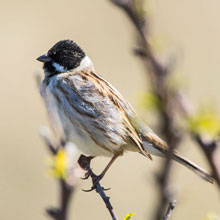
|
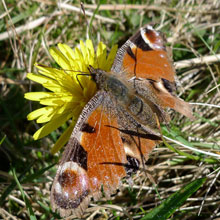
|
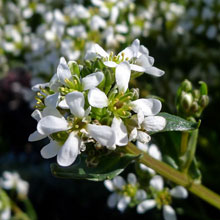
|
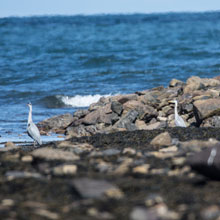
|
I decided to clamber over the 100m
or so of rocks to the sea’s edge in order to get better pictures of the
Gannets. John stayed perched on the beach preferring to " stay
well clear of a hip replacement episode". On the way I encountered a
friendly Meadow Pipit, it too was picking its way through the rocky
obstacles. I managed some satisfactory shots of the Gannets that were
passing at a rate of about 10/minute, albeit in a random fashion. Out
in the middle of the Firth of Forth a ship was sailing past, a UK LPG
tanker, TESSA KOSAN.
Encouraged by the encroaching sea,
I returned to the safety of the grassy path. I noticed a pair of
Cormorants on the rocks to the west, an adult and a juvenile. A small
flock of Oystercatchers passed overhead no doubt looking for drier
stances. As we rounded the Lighthouse John spotted another Reed Bunting
- it may even have been the same one. As we approached the path
bypassing the sandy beach we came upon a well-lit Skylark sitting on
the fence.
Cormorant
|
Oystercatcher
|
Reed Bunting
|
Skylark
|
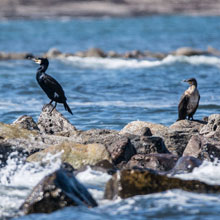
|
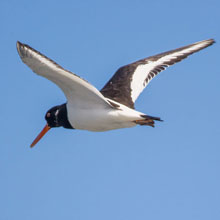
|
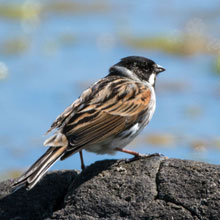
|
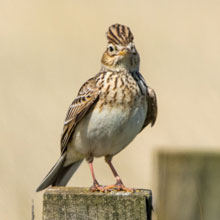
|
Rather than moving across the
beach, and into the sun, we had used the path to enter the beach
further east and then walk back west with the sun behind - better for
photographing any birds we saw, not just because the birds were better
lit, but to the birds we were in silhouette and, providing we didn’t
move too rapidly, we were hard to distinguish from inanimate object
such as trees! First birds sighted were a pair of Eider swimming quite
close in. We then came to very odorous rotting seaweed piles on which a
lot of birds were feeding. Another female Wheatear immediately caught
my eye and closeby on the rocks I realised I was being studied by a
beautiful female Shelduck.
Drake Eider
|
Female Eider
|
Female Wheatear
|
Shelduck
|
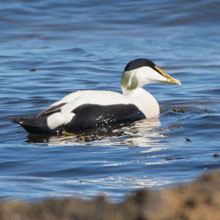
|
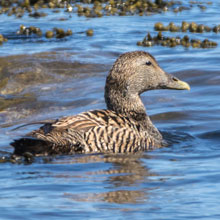
|
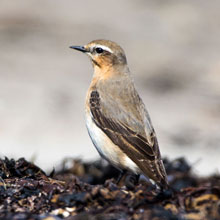
|
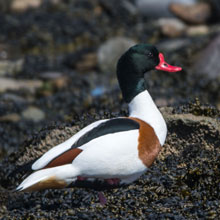
|
Then, parachuting in, a Skylark
descended onto the seaweed and, needless to say, the opportunity wasn’t
wasted. Yet another Reed Bunting appeared on the scene and, despite my
encroaching presence, wasn’t spooked. Then, a eureka moment as I picked
out a little spot of yellow, 30m ahead on the seaweed. It was the
Yellow Wagtail, and goodness, it certainly was yellow. I attempted to
creep nearer but couldn’t get close enough for a really clear shot
before it upped and went. A male Pied Wagtail stood its ground
wondering what all the fuss was about.
Skylark
|
Reed Bunting
|
Yellow Wagtail
|
Pied Wagtail
|
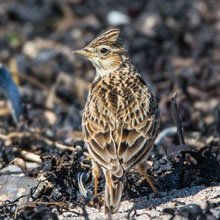
|
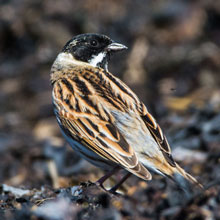
|
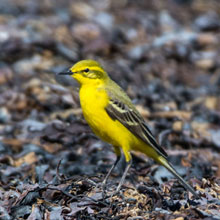
|
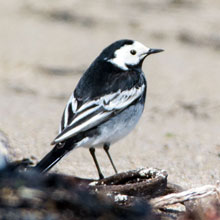
|
As we trekked back east along the
sandy beach we came across a rather bold female Wheatear that paused
long enough for a couple of useful captures. The last sighting before
leaving the sulfurous stench of the seaweed was of a male White
Wagtail, distinguished from the Pied by its light grey back and light
flanks. We then crossed the fenced-off area (a conservation grazing
scheme), south of the lighthouse, to reach the wooded area adjacent to
fields. Immediately I heard and then located a singing Yellowhammer,
glowing bright yellow in the strong Spring sunshine. We climbed a short
distance to a grassy area heavily populated with bright yellow Gorse
bushes.
John pointed out a Brown-lipped
Snail nestling deep in the Gorse bloom. As we sat in a corner of the
clearing, sheltered from the wind by tall conifers, I saw a couple of
Goldfinches twittering as they sat by the pine cones. A calling
Chaffinch also paid a visit (see Pictures of the Week below). As we
neared the car park, having trodden out a big circle around the
lighthouse, I noticed that White Deadnettle plants were starting to
flower. And resting on a nettle leaf was a female Orange-Tip butterfly,
a true sign of Spring.
Brown - lipped Snail
|
Goldfinch
|
White Deadnettle
|
Female Orange Tip Butterfly
|
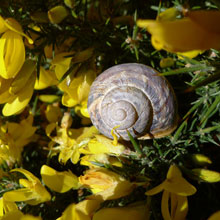
|
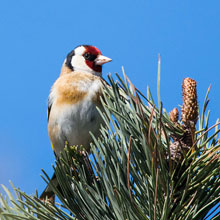
|
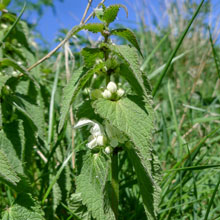
|
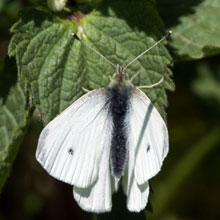
|
We weren’t sure when we set off if
Barns Ness would come up with the goods, as sometimes it can be a bit
quiet. We needn’t have worried as we got lots of fine and varied
captures in excellent light. That was well worth teas and Danish
pastries (although we’d have finished with these in any eventuality!).
Pictures of the Week
Skylark
|
Gannet
|
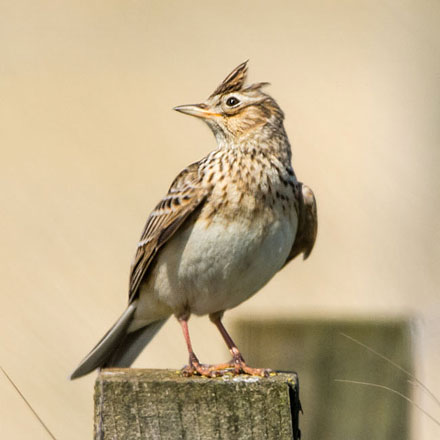
|
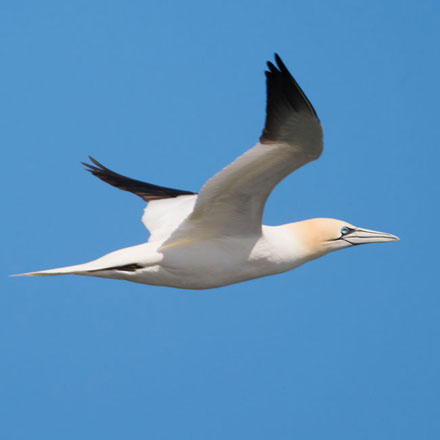
|
Shelduck
|
Chaffinch
|
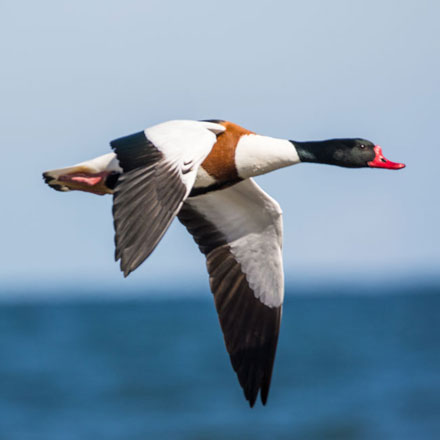
|
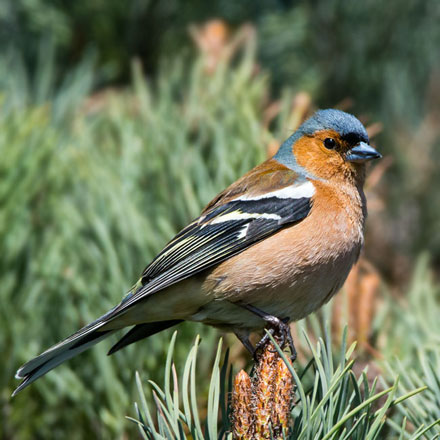
|
19th April 2018
RSPB Leighton Moss
While on holiday in the Lake
District I popped south to RSPB Leighton Moss, just to the North of
Morecambe Bay. The weather was excellent - bright blue skies with
unbroken sunshine, so when I set off round the reserve I was filled
with eager anticipation. I hoped to cross paths with Bittern, Marsh
Harrier, Bearded Tit and Cetti Warbler. The reserve has 7 hides. I
decided to start with the two hides at the north end of the site, the
Causeway and Lower hides.
I walked along the Causeway, a very
long straight path with 6 feet high reeds to the left and right. Every
so often there were gaps in the reeds where canals cut across, or where
there were small clearings in the marsh. At one of these there are a
few bird tables with the aim of encouraging Bearded Tits. Sadly they
didn’t show. There were some Greylags there but I did hear the booming
sound of a Bittern which was like a giant blowing across the mouth of a
big bottle! I also heard an otherwise elusive Cetti Warbler. It sounded
a bit like a very loud Wren call. From the Causeway hide I took
pictures of some familiar birds that gave the distinct impression that
love was in the air, Gadwall, Tufted Ducks, Great Crested Grebes and
Shoveler pairs were obviously courting.
Gadwall
|
Tufted Duck
|
Great Crested Grebe
|
Shoveler
|
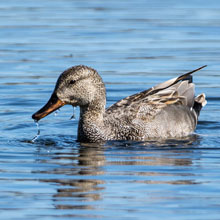
|
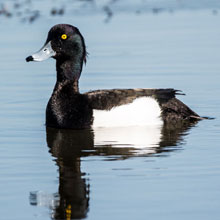
|
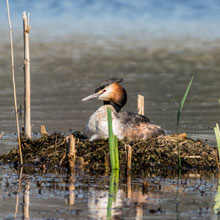
|
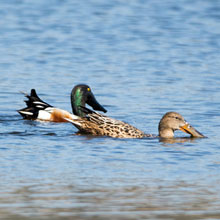
|
There was also a fair bit of
aerial activity that tested my camera skills as birds darted across the
front of the hide. Greylags, Grey Heron, and a group of Shelduck
passed. And, just as I left the hide, a Marsh Harrier circled directly
overhead.
Greylag Goose
|
Grey Heron
|
Shelduck
|
Marsh Harrier
|
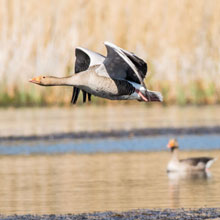
|
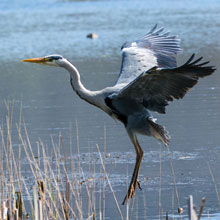
|
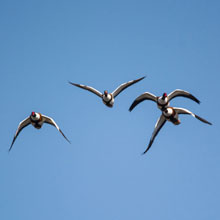
|
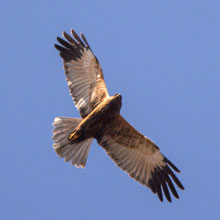
|
Further along the Causeway there
was further raptor excitement when I spotted a hunting Osprey over some
open water. It made several loops in the near distance but,
disappointingly, it didn’t swoop down to catch a fish. As I snapped the
Osprey, a Greylag landed in the water to the front of me, then a
Cormorant sped past - busy place! At the end of the Causeway I turned
left through a gate leading to the Lower hide some 200m beyond. As I
passed through the gate I was met by a very fine cock Pheasant clucking
to its mate lurking in the undergrowth.
Osprey
|
Greylag Goose
|
Cormorant
|
Pheasant
|
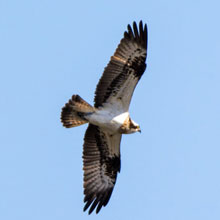 |
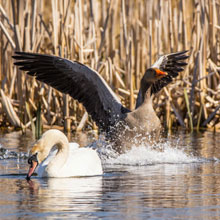
|
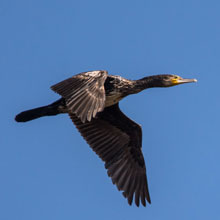
|
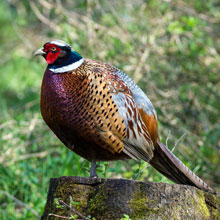
|
As I moved slowly along the path I
could hear, “teacha, teacha, teacha”, the call of the Great Tit. This
led me to find it wooing it’s mate in a low tree. Beyond this I then
heard the descending tones of a Willow Warbler sitting boldly on the
branches of a well lit tree. From the Lower hide I couldn’t see much
nearby other than a single Lapwing. But just as I left the hide, a
Marsh Harrier flew low over the reeds, although it didn’t come as close
as I’d have liked.
Great Tit
|
Willow Warbler
|
Lapwing
|
Marsh Harrier
|
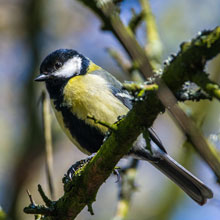
|
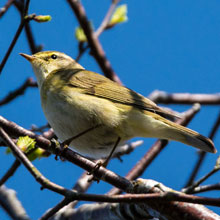
|
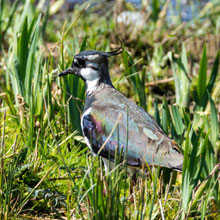
|
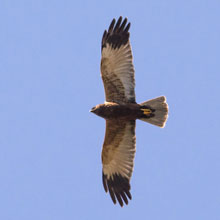
|
I then made my way back to the
Visitor Centre car park and drove about half a mile south to the Eric
Morecambe Hide perched between pools at the north edge of Morecambe
Bay. There I found that the source of the bird noise I’d been hearing
on my approach was actually coming from hundreds of nesting
Black-headed Gulls. I was delighted though to find four pairs of Avocet
feeding in the water around the island in the middle of the right pool.
I spotted one Avocet sitting on a nest as its mate aggressively poked
away any birds that invaded their space. In the left pool a group of
Shelducks were in the throes of courting disputes. Their bad-tempered
exchanges were spectacular but no birds seemed to come to harm.
I then drove back to the Visitor
Centre to explore the remaining areas of the reserve. At Lillian’s Hide
I got a clear picture of a female Pheasant that was unusually tame.
Inside the hide I got shots of a Little Egret feeding in the low reeds.
From the Tim Jackson hide I got nice views of feeding Teal. I got my
closest views of a Marsh Harrier (see Pictures of the Week) from the
Grisedale Hide. There seemed to be two pairs nesting within view of the
hide. On my way back to the Visitor Centre I came across a few
Blackcaps cavorting in the bushes, the males calls reminding me of Eric
Morecambe’s line that the tune has “all the right notes, but not
necessarily in the right order”!
Female Pheasant
|
Little Egret
|
Teal
|
Black Cap
|
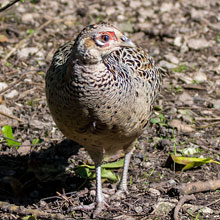
|
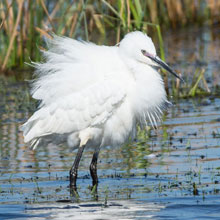
|
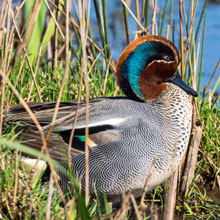
|
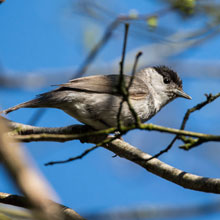
|
At the end of the afternoon, my
final captures were around the Visitor Centre. I noticed that the nice
warm weather was encouraging some wildflowers into bloom. Beautiful
white Wood Anemones lined some of the paths, while the rather
unattractive green Dog’s Mercury had also sprung up. Under a footbridge
very pretty yellow Marsh Marigolds were also freshly blooming. As I,
and other visitors left the reserve, a fearless Robin sang at shoulder
level from a pathside tree, as if it was bidding us farewell until we
meet again.
Wood Anemone
|
Dogs Mercury
|
Marsh Marigold
|
Robin
|
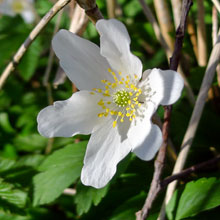
|
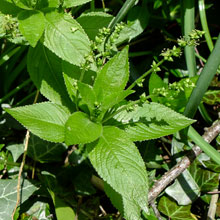
|
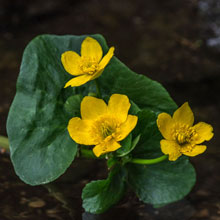
|
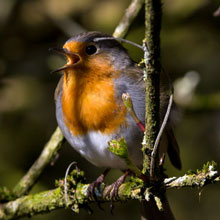
|
I didn’t get sight of a Bittern,
Bearded Tit or Cetti Warbler, but this just gives me a great excuse to
return to Leighton Moss, which surely must be one of the top RSPB
sites. It never fails to impress.
Pictures of the Week:
Osprey
|
Greylag Goose
|
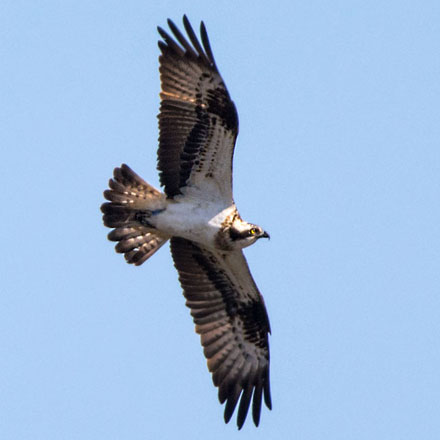
|
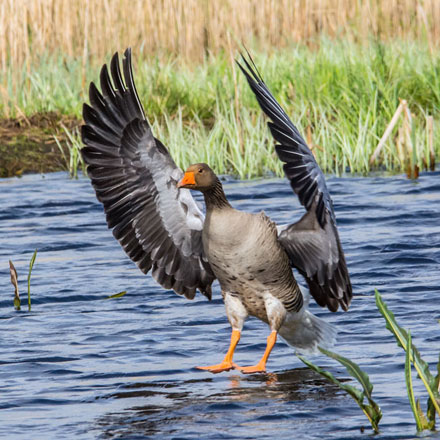
|
Pheasant
|
Marsh Harrier
|
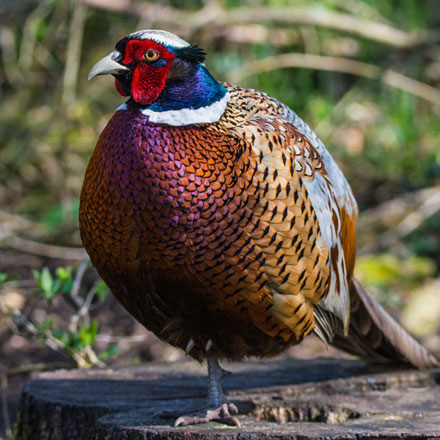
|
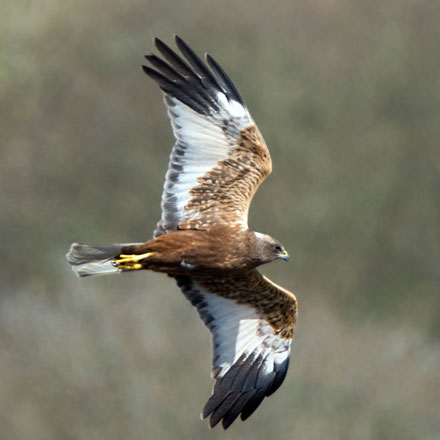
|
15th April 2018
Musselburgh
As we began our walk along what
I’ll call the “sea promenade” east of the mouth of River Esk at
Musselburgh (although it is not really pedestrian-friendly as it is
muddy, pitted and very often flooded), the sun was making frequent
appearances, colouring what had, for most of the last month, been
various shades of grey. An encouraging first picture was of a Peacock
butterfly taking in the heat of the sun from within the shelter of
tufts of grass. Also resting, just below the seawall, were a pair of
Mallards. The mouth of the Esk was disappointingly free of birds apart
from a lone Mute Swan. The tide was high and feeding time was over for
some species. We nearly missed very well-camouflaged Turnstones
nestling on low rocks below us.
Peacock Butterfly
|
Mallard
|
Mute Swan
|
Turnstone
|
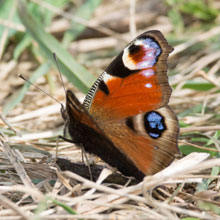
|
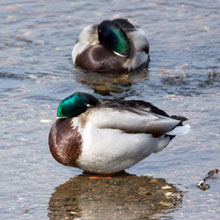
|
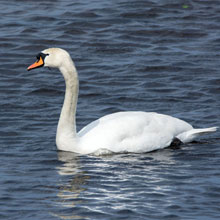
|
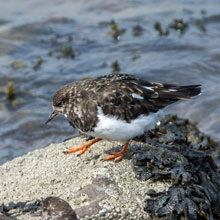
|
Flocks of Oystercatchers passed,
probably heading for roosting areas such as the Scrapes, where we were
also headed. As we walked further east, quite a few male and female
Goldeneye and Eider were bobbing about on the waves some 50m out. There
were a few very distant Velvet Scoters and Long-tailed Ducks, but they
were too far out for decent pictures. The odd passing Curlew also drew
our attention as they too flew in the direction of the Scrapes.
Oystercatcher
|
Female Goldeneye
|
Eider
|
Curlew
|
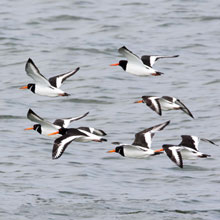
|
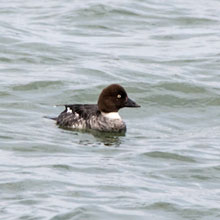
|
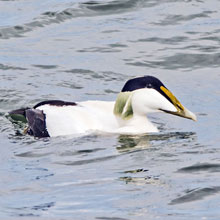
|
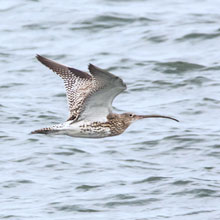
|
At the Scrapes we found what we expected, lots of Redshanks, a few Teal, tens of Oystercatchers and a few Wigeon.
Redshank
|
Teal
|
Oystercatcher
|
Wigeon
|
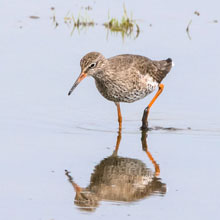
|
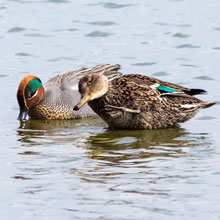
|
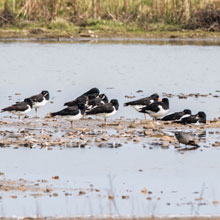
|
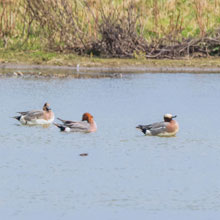
|
Half a dozen Wood Pigeons were
quite active between the Scrapes. They may have been indulging in
courting behaviour. A male and female Teal pair dabbled their way past
the hide allowing some well-lit photo opportunities. The biggest
photo-opportunities, however, presented themselves when four of nine
Shelduck, that had been in the furthest Scrape, flew into the Scrape in
front of our hide.
Wood Pigeon
|
Drake Teal
|
Female Teal
|
Shelduck
|
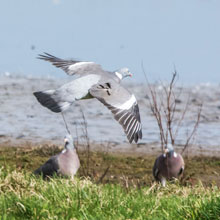
|
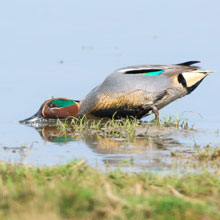
|
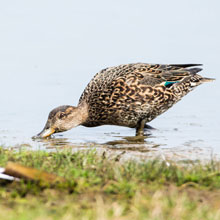
|
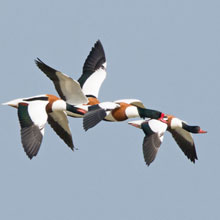
|
Another two, a male and a female
followed a minute or two later. Eventually all nine were in front of
us. We were treated to a show of Shelduck courting procedures as the
males jostled for position near the females, occasionally calling with
pleading and rather plaintive sounds.
Once we’d had our fill of the
Scrapes we left and made our way back to the car. We had only reached
the Boating Pond when I saw a pair of Willow Warblers that,
conveniently, sang their very familiar song of descending tones,
allowing me to determine that they were Willow Warblers and definitely
not Chiffchaffs. In the grassy areas surrounding the Pond I found
patches of the early flowering Germander Speedwell and also lots of
Coltsfoot. There wasn’t much to add to our haul of pictures after that,
just a close flypast of a Cormorant in its mating plumage.
Willow Warbler
|
Germander Speedwell
|
Coltsfoot
|
Cormorant
|
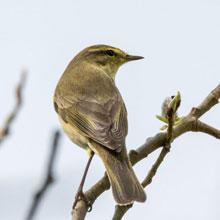
|
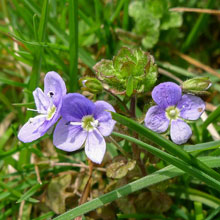
|
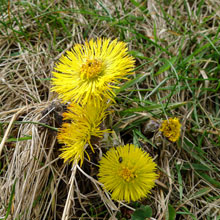
|
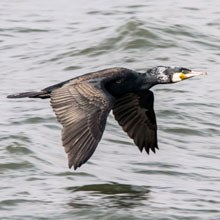
|
Back in the car we decided to
drive the short distance east to Port Seaton to see if we could catch
the last stage of the incoming tide as it finally covered the rocks
there and drove the birds near to the shore. We were too late though.
There was nothing to see but the sea. That didn’t stop us enjoying our
tea and Danish pastries, after all, we had had a successful day in
relatively lovely weather - what’s not to like about that!
Pictures of the week:
Mute Swan
|
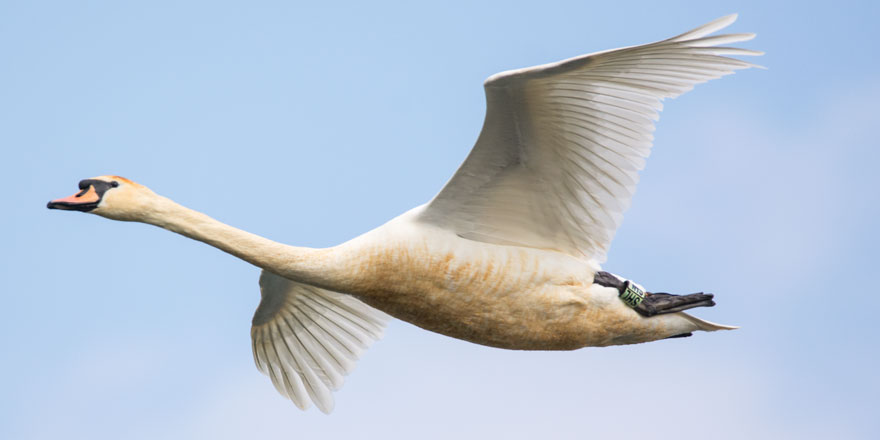
|
Turnstone
|
Shelduck
|
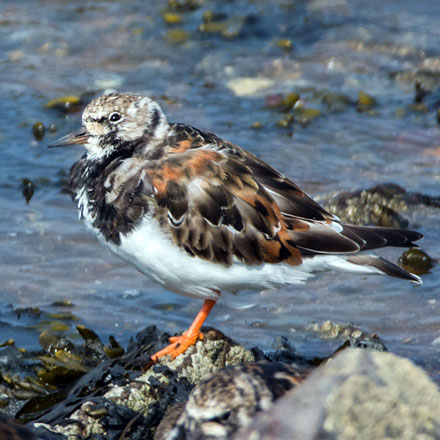
|
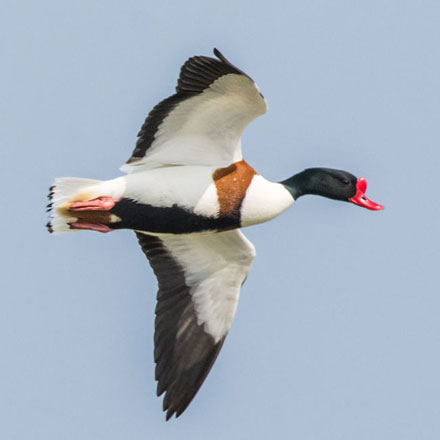
|
8th April 2018
Skateraw and Belhaven Bay
Brighter weather was predicted for
the Dunbar area than any other part of the Central Belt so that is
where we headed for - specifically Skateraw as there had been sightings
of a male and female pair of Black Redstarts there. So after our
customary Dalkeith Morrisons breakfasts (8.5/10) we were soon at the
Skateraw car park, which was nearly full, such was the interest in the
Redstarts. We clambered east along the rocky shore past the old
limekiln towards Torness power station. Our first sightings were of a
quite distant Pied Wagtail and beside it a singing Wren. Fellow
birders already on the site described how we’d just missed the
Redstarts but we hung about for a bit to see if they’d reappear, but to
no avail. While we waited, a female House Sparrow paid us a visit and I
captured some images of some recently flowered Common Scurvygrass.
Pied Wagtail
|
Wren
|
Female House Sparrow
|
Common Scurvygrass
|
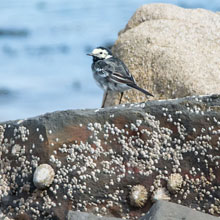
|
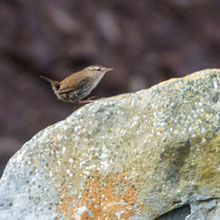
|
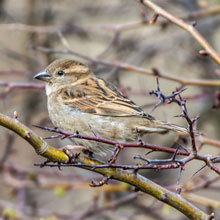
|
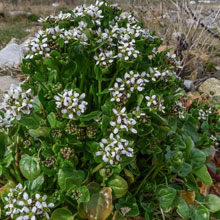
|
Scurvygrass got its name from the observation that it cured scurvy, and it was taken on
board ships in dried bundles and included in sailors diets. When I examined my
Scurvygrass pictures I noticed that an insect was prowling among the flowers. I
think it was the Sawfly, Dolerus Gonager looking for places to lay her eggs.
You may see the sting-like tail that is actually its genitalia specially
adapted for penetrating surfaces to deposit eggs. As the Redstarts had seemed to
have disappeared we then did our usual circuit out to the west side of the bay
to observe the birds present at the rocky outcrops there. That too was a bit of
a disappointment as there had been a clean-up operation going on brought about
by a spillage of wooden planks into the sea from a vessel some 100 miles to
the south. Apparently the planks made landfall over an area stretching from
Torness to St Andrews. At any rate, the workmen scared all the birds away!
However a beautifully-lit Reed Bunting treated us to some nice
photo-opportunities but other birds were few and far between. Just as a
juvenile Herring Gull flew overhead, we decided to cut our losses and trudge
back to the site of the Redstarts to see if they’d reappeared.
| Sawfly - Dolerus gonager |
Reed Bunting
|
View
|
1st Cycle Herring Gull
|
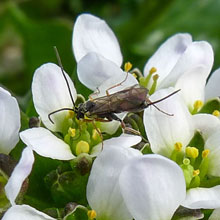
|
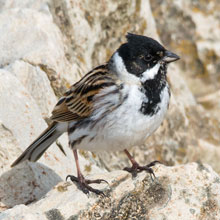
|
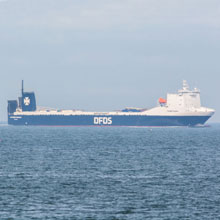
|
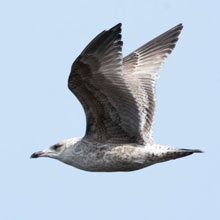
|
On our way I nearly got a picture
of a female Reed Bunting, then some Curlews made a flypast just as we
neared where we thought the Redstarts might be. Overlooking this spot
was a tower associated with the Power Station. Nine Cormorants were
perched there unconcerned by the accumulation of the birders gathered
before them. Then at last I got some brief glimpses of the Black
Redstarts, albeit from 50m away. I would have got some closer views
were it not for the amount of observers and passing walkers.
Female Reed Bunting
|
Curlew
|
Cormorant
|
Black Redstart
|
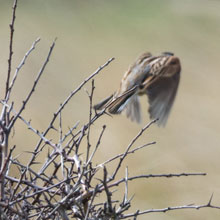
|
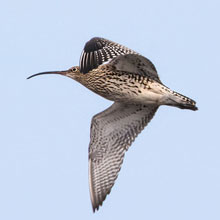
|
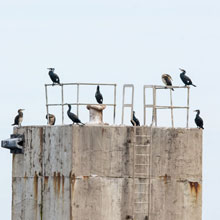
|
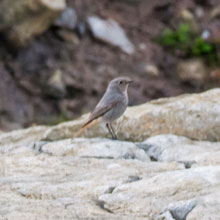
|
I did get another passable shot of
the Black Redstart before we moved on. On our way back to the car I
managed shots of the familiar birds, Meadow Pipit, and Robin, which are
not usually seen on rocky shores. Also a Rock Pipit moved across the
rocks in courting mode, with head bowed and wing tips lowered.
Black Redstart
|
Meadow Pipit
|
Robin
|
Rock Pipit
|
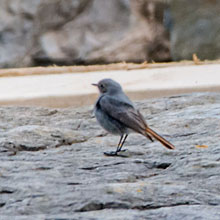 |
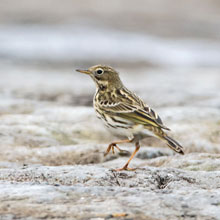 |
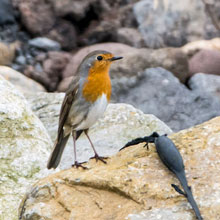
|
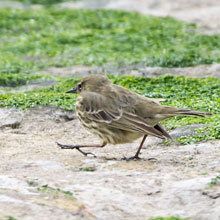
|
We changed location to Belhaven
Bay, west of Dunbar, but found it deserted. A pair of Mallards made
their getaway as we approached the seawall. But as we sat bemoaning the
lack of feathery friends a Rock Pipit descended before us, as they do
during their breeding season, and landed on a well lit spot just on the
other side of the wall like a gift from the heavens. At Seafield Pond
our bad luck seemed to continue as it was in flood. But I glimpsed a
Common Sandpiper feeding with some Moorhens. On our return to the car a
patrolling Herring Gull glided past and I said, “time for Tea and
Danish pastries”.
Mallard
|
Rock Pipit
|
Common Sandpiper
|
Herring Gull
|
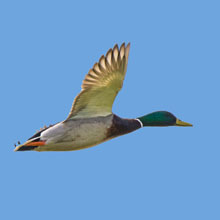
|
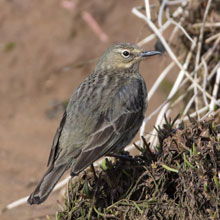
|
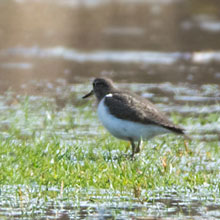
|
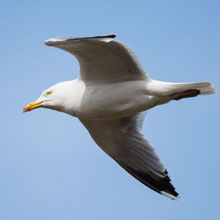
|
Not our most prolific week but we
managed a pleasing variety of sightings in fine comfortable weather -
and the apple and caramel lattice pastries were very fine!
Pictures of the Week:
Reed Bunting
|
Common Scurvygrass
|
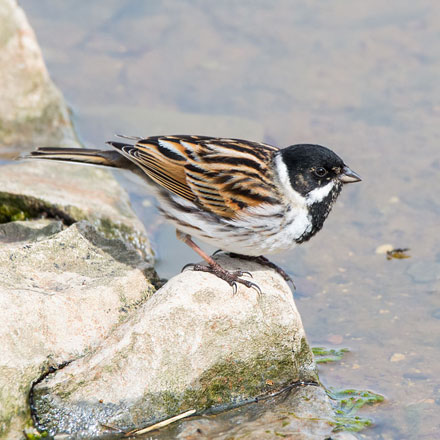
|
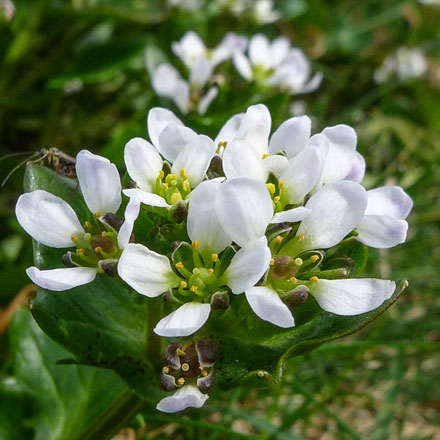
|
Rock Pipit
|
Herring Gull
|
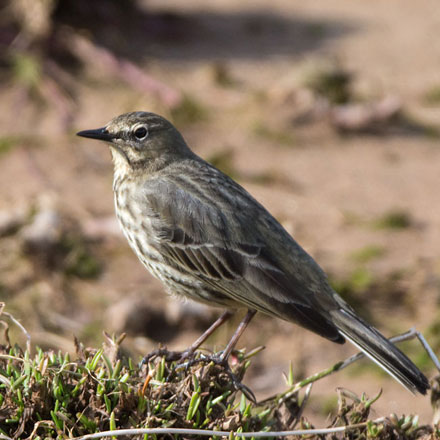
|
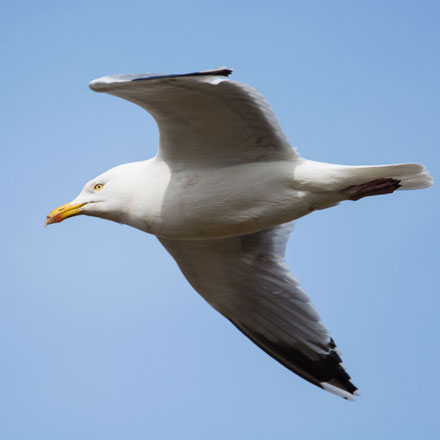
|
1st April 2018
Aberlady and Port Seton
Oh dear, it was one of those
visits where all looked promising over our Dalkeith Morrisons breakfast
(9.5/10; -0.5 for burst fried egg) until we left and headed for
Aberlady, where, on arrival, the skies darkened and didn’t really
recover until we got home. To see how bad the light was, see our first
picture, of Starlings passing overhead, taken as we crossed the wooden
bridge over the Peffer Burn. Apart from a few distant Redshanks and
Mallards, the first part of our walk was very quiet - and dull, dull,
dull! It wasn’t until we were past a deserted Marl Loch that a couple
of photo-opportunities presented themselves- a pair of Greylags in the
long grass and a lone Roe Deer buck. Further along the route to the
dunes we entered an area that showed a lot of Skylark activity. I
caught a shot of one sitting in a leafless bush by the footpath.
Starling
|
Greylag
|
Roe Deer
|
Skylark
|
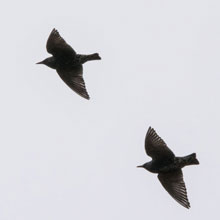
|
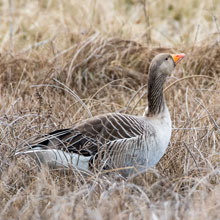
|
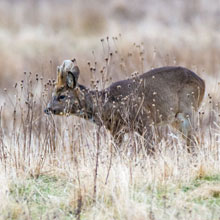
|
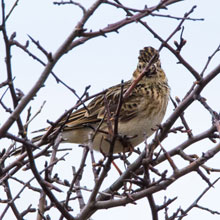
|
As we watched a few Larks
ascending (Vaughan William’ music in my head), a flock of Teal passed
by, obviously in a disturbed state. Something must have put them up
from the pond some 100m to the east, maybe a wayward golf shot! Next we
came across a Meadow Pipit posing on a concrete block. Maybe it
couldn’t see us -the light was that poor. We clambered over the dunes
that line the long sandy beach at the East side of Aberlady Bay. The
view of the shore that met us left us quite downhearted as it was
completely devoid of birds. Nevertheless, we descended down onto the
beach and plodded back towards the footbridge, hoping that we would
find something. We did indeed see some birds, a few distant Shelducks
dabbling in the shallows.
Teal
|
Meadow Pipit
|
Eider
|
Shelduck
|
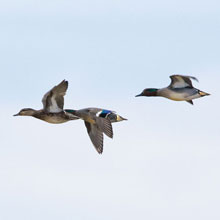
|
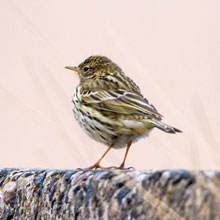
|
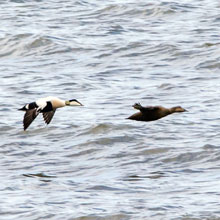
|
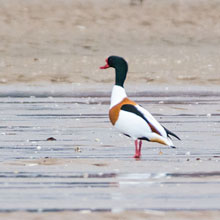
|
As we moved across the marshland
towards the main footpath, we had a couple of unexpected sightings. The
first was of a big Hare I disturbed as I picked my way through the salt
marsh. It was up and away before I got my camera going. The other
sighting was equally as sudden. I put up a group of what looked like
Woodcocks that had been resting unseen in the long grass. Again they
were too fast for me, but it was an exhilarating moment. Looking over
to the Firth of Forth we could see it was fairly busy with sea vessels.
Below is a picture of the SMT Seraya, an offshore supply ship. We could
also see a couple of oil tankers and a container ship. Looking south
the sky showed looming sleet showers so we pressed on with increased
vigour before the bad weather caught up with us. A Herring Gull and a
passing Greylag were our final shots at Aberlady. We left longing for
better weather and the time there, when there would be flowers and
invertebrates to photograph.
SMT Seraya
|
View
|
Herring Gull
|
Greylag Goose
|
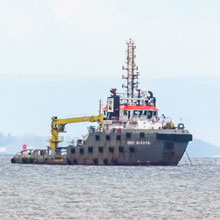
|
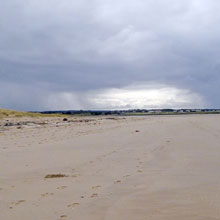
|
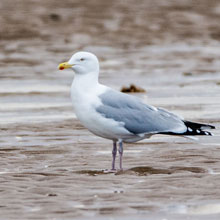
|
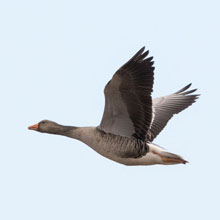
|
We made for Port Seton where it seemed bit brighter. At Seton Burn we
spotted an Oystercatcher by the shore. John was intrigued by a large number of
sponge-like deposits that were on the sandy shore. These were Whelk egg cases
displaced by stormy weather from their rocky positions in the sea. A flock of
Turnstones flew in to feed by the shore. Also there were some Curlew that
continued to fly in as we observed them.
Our final location was at the
promenade leading from Port Seton Harbour. A fairly large flock of
mainly Sanderling with a lot of Dunlin was moving swiftly around the
rocks. The incoming tide had just about completely flooded the rocks
and the flock was obviously seeking a dry place to settle. This turned
out to be close to where we were standing. It’s a pity the light was
very poor as there were some great opportunities for great shots. I did
my best though with light I had though. Groups of courting Eider were
moving around just offshore, several drakes chasing each female. A
female that had shaken off her suitors took time to flap her damp wings
before she was once again a target of attention. This was our final
shot.
Although the quality of our
photographs could have been vastly improved if the sun had made an
appearance, we did fairly well and had captured pictures of a fair
number of interesting sightings. We took shelter in the car from the
bitter wind and celebrated with warm tea accompanied by jam and
cream-filled scones - lovely!!
Pictures of the week:
Meadow Pipit
|
Turnstone
|
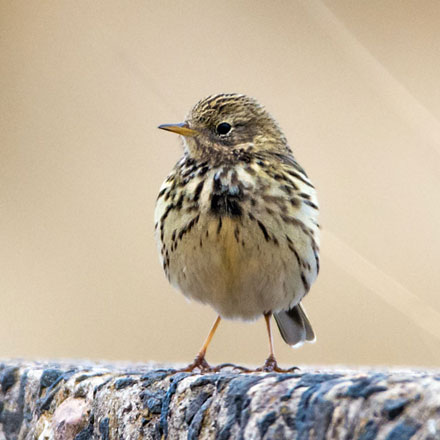
|
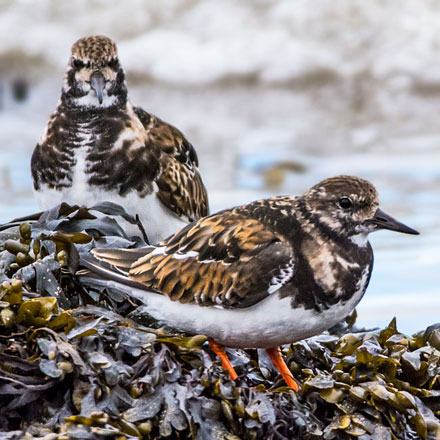
|
Curlew
|
Sanderling
|
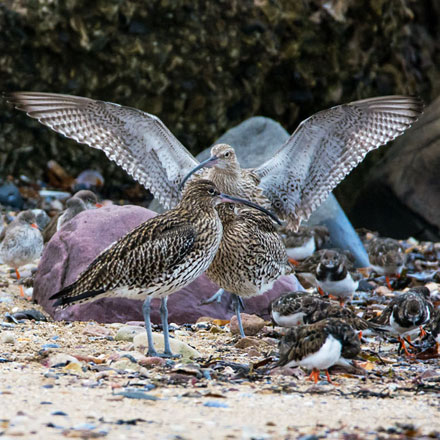
|
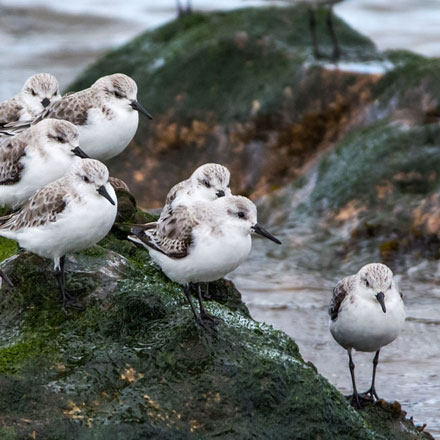
|
Back To Top
|

